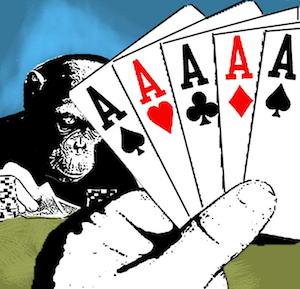Those who have read Robert Bellah’s magisterial Religion in Human Evolution know that Bellah is fond of the idea that mammalian “play” played an important role in the eventual evolution of (human) minds that could cognize along religious lines. The basic idea, which borrows heavily from Johann Huizinga’s classic study of the play element in culture, is that play freed hominins — at least for a bit — from the nearly constant distress that accompanies normal selection pressures. Play thus opens up, at least metaphorically, cognitive space to roam and explore consciousness. These explorations, in turn, naturally lead to concepts and ideas that today we would characterize as “religious.”
It’s a plausible argument. We can therefore add “play” to the list of faculties, propensities, habits, and aspects of mind which form the substrate for religious ideation.
Having been primed to play by Bellah, I was startled the other day by this: “The opposite of play is not what is serious, but what is real.” Freud said this. He was being quoted by Maria Popova in an entirely different (creative writing) context:
Should we not look for the first traces of imaginative activity as early as in childhood? The child’s best-loved and most intense occupation is with his play or games. Might we not say that every child at play behaves like a creative writer, in that he creates a world of his own, or, rather, rearranges the things of his world in a new way which pleases him? It would be wrong to think he does not take that world seriously; on the contrary, he takes his play very seriously and he expends large amounts of emotion on it.
The opposite of play is not what is serious but what is real. In spite of all the emotion with which he cathects his world of play, the child distinguishes it quite well from reality; and he likes to link his imagined objects and situations to the tangible and visible things of the real world. This linking is all that differentiates the child’s ‘play’ from ‘phantasying.’
The creative writer does the same as the child at play. He creates a world of phantasy which he takes very seriously — that is, which he invests with large amounts of emotion — while separating it sharply from reality.
This gets at something important. Humans straddle two worlds: the symbolic (in our minds) and the physical (around us). We inhabit both, and the continuous looping process that links them seems to inevitably give rise to animist-religious ideas.



